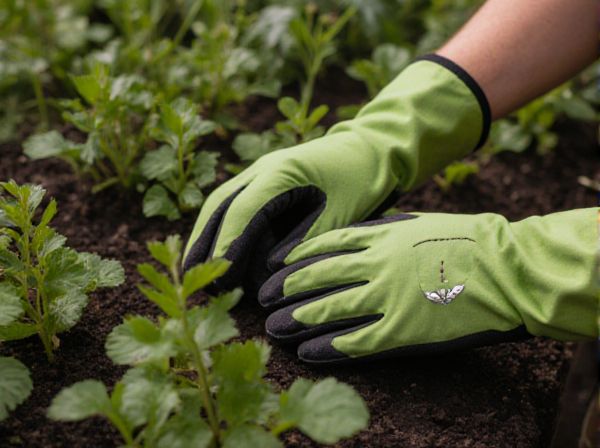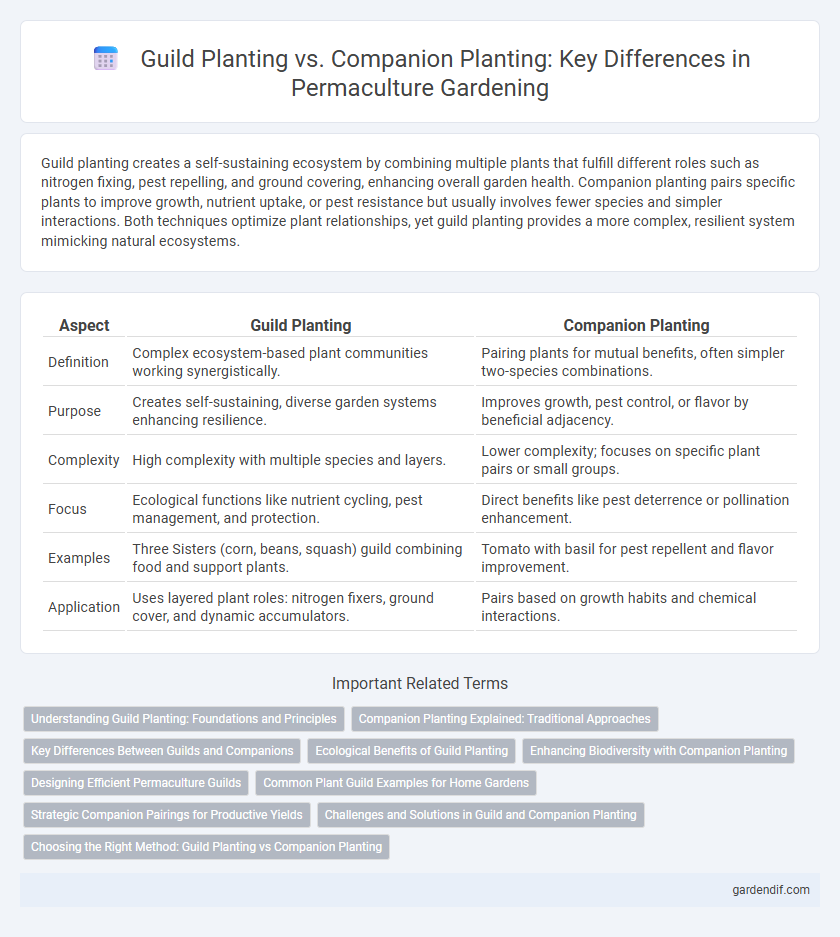
Guild Planting vs Companion Planting Illustration
Guild planting creates a self-sustaining ecosystem by combining multiple plants that fulfill different roles such as nitrogen fixing, pest repelling, and ground covering, enhancing overall garden health. Companion planting pairs specific plants to improve growth, nutrient uptake, or pest resistance but usually involves fewer species and simpler interactions. Both techniques optimize plant relationships, yet guild planting provides a more complex, resilient system mimicking natural ecosystems.
Table of Comparison
| Aspect | Guild Planting | Companion Planting |
|---|---|---|
| Definition | Complex ecosystem-based plant communities working synergistically. | Pairing plants for mutual benefits, often simpler two-species combinations. |
| Purpose | Creates self-sustaining, diverse garden systems enhancing resilience. | Improves growth, pest control, or flavor by beneficial adjacency. |
| Complexity | High complexity with multiple species and layers. | Lower complexity; focuses on specific plant pairs or small groups. |
| Focus | Ecological functions like nutrient cycling, pest management, and protection. | Direct benefits like pest deterrence or pollination enhancement. |
| Examples | Three Sisters (corn, beans, squash) guild combining food and support plants. | Tomato with basil for pest repellent and flavor improvement. |
| Application | Uses layered plant roles: nitrogen fixers, ground cover, and dynamic accumulators. | Pairs based on growth habits and chemical interactions. |
Understanding Guild Planting: Foundations and Principles
Guild planting is a holistic permaculture technique that integrates multiple plant species to create mutually beneficial relationships, enhancing ecosystem health and productivity. It relies on foundational principles such as diversity, functional redundancy, and ecological balance to optimize nutrient cycling, pest control, and soil fertility. Key components of guild planting include nitrogen-fixing plants, dynamic accumulators, ground covers, and pest-repellent species working synergistically within a shared space.
Companion Planting Explained: Traditional Approaches
Companion planting involves strategically placing specific plants together to enhance growth, deter pests, and improve soil health based on traditional agricultural knowledge. Classic examples include planting basil alongside tomatoes to repel aphids or combining corn, beans, and squash in the Three Sisters guild to maximize space and nutrient use. This method leverages time-tested symbiotic relationships to create balanced ecosystems without synthetic inputs.
Key Differences Between Guilds and Companions
Guild planting involves a structured polyculture system where multiple plant species work synergistically to support a central element like a fruit tree, enhancing nutrient cycling, pest control, and habitat diversity. Companion planting typically pairs two or three species to provide mutual benefits such as pest deterrence or improved growth, focusing on simpler, direct plant interactions. The key difference lies in guilds' complex, multilayered design and ecological functions versus companions' straightforward, often bilateral relationships.
Ecological Benefits of Guild Planting
Guild planting enhances ecosystem resilience by mimicking natural plant communities, promoting biodiversity and supporting beneficial insect populations. It improves soil health through complementary root structures and nutrient cycling, reducing the need for chemical fertilizers. This method fosters pest control and pollination services, creating a self-sustaining and productive agricultural system.
Enhancing Biodiversity with Companion Planting
Guild planting creates mutually beneficial plant communities by combining trees, shrubs, and ground covers to enhance soil health and support diverse wildlife. Companion planting strategically pairs specific plant species to repel pests, attract pollinators, and improve nutrient uptake, boosting overall garden resilience. Both methods increase biodiversity but companion planting specifically targets pest control and pollination enhancement through species interactions.
Designing Efficient Permaculture Guilds
Guild planting in permaculture involves creating multifunctional plant communities that support each other's growth through complementary functions like nitrogen fixation, pest deterrence, and nutrient accumulation, whereas companion planting primarily focuses on pairing plants to benefit each other in simpler, often two-species interactions. Designing efficient permaculture guilds requires integrating diverse species with varying root depths, growth habits, and yields to maximize resource use and resilience within an ecosystem. Effective guilds enhance soil health, increase biodiversity, and promote sustainable yields by mimicking natural plant relationships beyond basic companion planting techniques.
Common Plant Guild Examples for Home Gardens
Common plant guild examples for home gardens include the Three Sisters guild, combining corn, beans, and squash to enhance nutrient use and pest resistance. Another popular guild involves fruit trees surrounded by nitrogen-fixing plants like clover and dynamic accumulators such as comfrey to improve soil fertility. Herb and flower guilds, featuring plants like basil, marigold, and nasturtium, support pest control and pollination around vegetables or fruit crops.
Strategic Companion Pairings for Productive Yields
Guild planting creates synergistic plant communities by combining multiple species that support each other's growth through nutrient cycling, pest control, and habitat provision, improving soil health and maximizing space. Companion planting focuses on strategic pairings of two or more plants that enhance growth, deter pests, or improve flavor, increasing yields and reducing the need for chemical interventions. Incorporating diverse companion pairings within guilds leverages ecological relationships to optimize productivity and resilience in permaculture systems.
Challenges and Solutions in Guild and Companion Planting
Guild planting faces challenges such as complex plant interactions and managing nutrient competition, which can be mitigated by careful species selection based on complementary root depths and growth habits. Companion planting often struggles with pest management inconsistencies and limited plant pairings, addressed through experimental trialing and incorporating diverse insect-repellent species. Both methods benefit from ongoing observation and adaptive planning to optimize plant health and productivity.
Choosing the Right Method: Guild Planting vs Companion Planting
Choosing between guild planting and companion planting depends on garden goals and ecosystem complexity. Guild planting integrates diverse species in a self-sustaining ecosystem to enhance soil fertility, pest control, and plant support, making it ideal for permaculture designs. Companion planting targets specific plant pairings to improve growth or deter pests, suitable for simpler garden setups or targeted crop improvements.
Guild Planting vs Companion Planting Infographic

 gardendif.com
gardendif.com